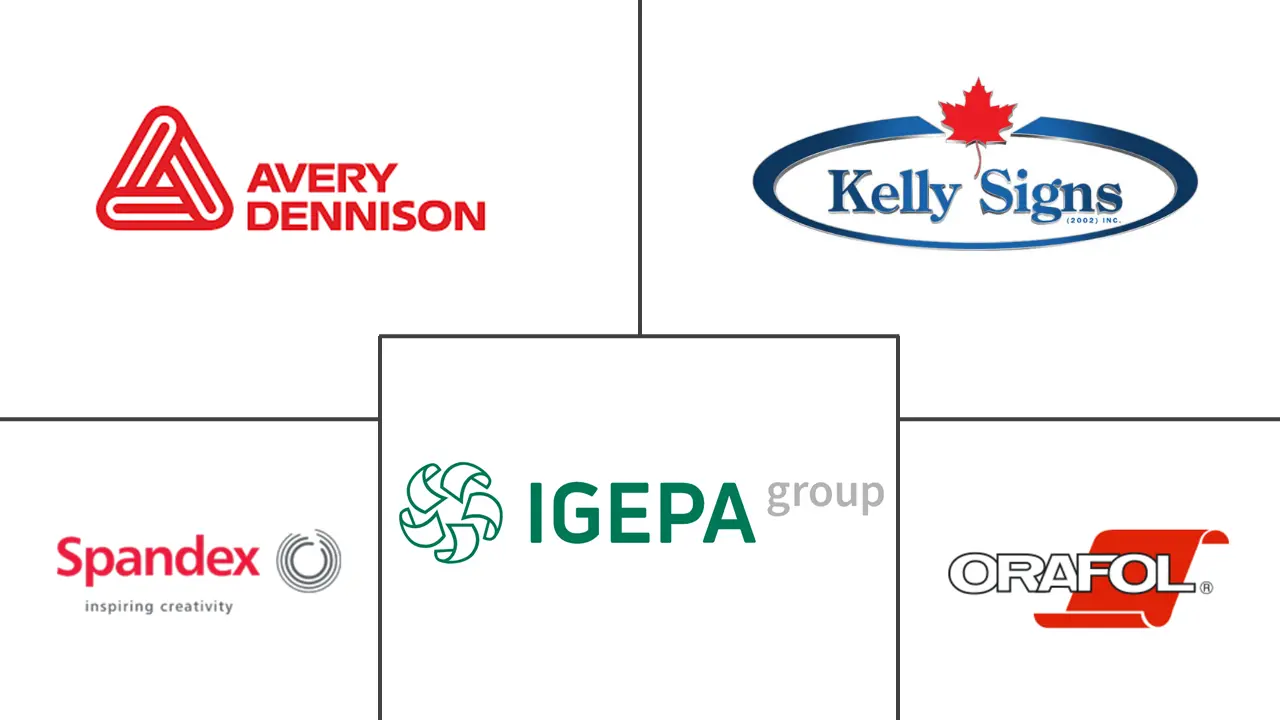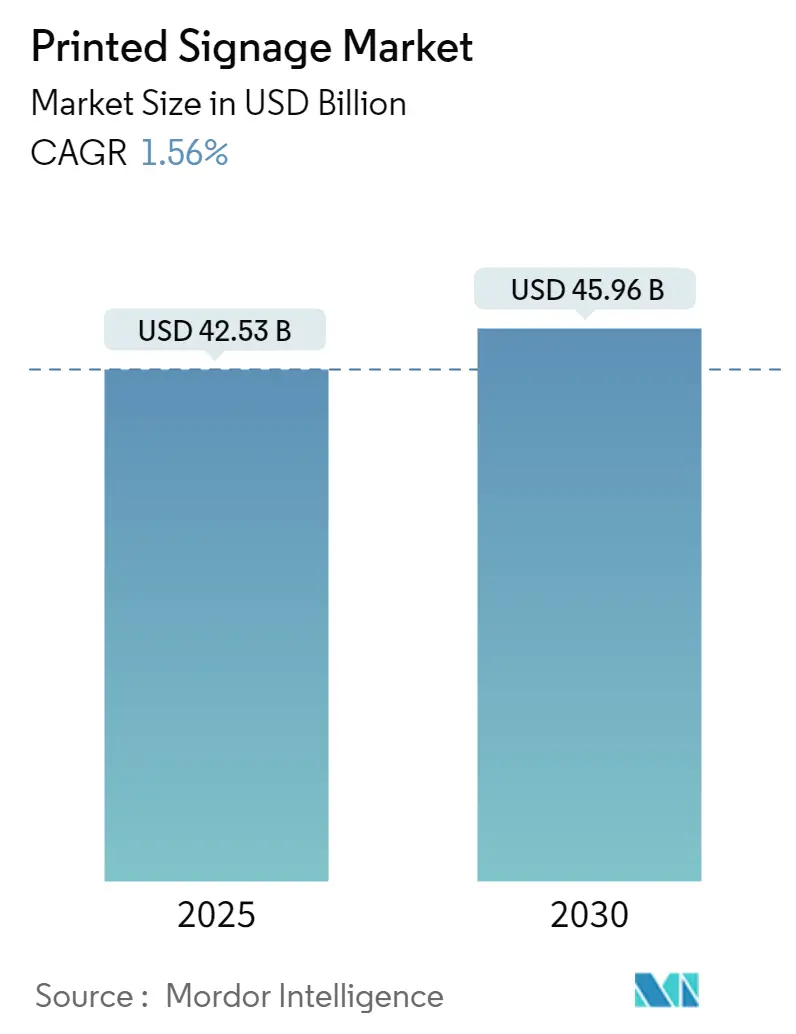
Printed Signage Market Analysis
The Printed Signage Market size is worth USD 42.53 Billion in 2025, growing at an 1.56% CAGR and is forecast to hit USD 45.96 Billion by 2030.
The printed signage industry is experiencing significant consolidation through strategic acquisitions and partnerships, reflecting the market's evolution towards integrated service offerings. A notable example is Strategic Factory's recent acquisition of Baltimore sign manufacturer A|A Signs, expanding their portfolio to include building signage, pylon signs, monument signs, and vehicle graphics. This trend of consolidation enables companies to offer comprehensive solutions while maintaining competitive advantages in specific market segments. According to a Canon USA survey, 76% of Americans indicate that print quality and graphics have the ability to capture consumer attention, highlighting the continued relevance of high-quality printed signage despite digital alternatives.
Technological advancements in printing capabilities are reshaping the industry landscape, particularly in large format printing and 3D printing applications. Companies are investing in sophisticated UV flatbed printers and wide-format printing solutions to enhance production efficiency and quality. For instance, in November 2021, Paddock Digital Printing invested in Acuity Ultra to enhance its signage production business, focusing on improving turnaround times while maintaining premium quality. The investment in advanced printing technologies reflects the industry's commitment to innovation and meeting evolving customer demands for both indoor and outdoor applications.
Environmental sustainability has emerged as a crucial focus area, with manufacturers increasingly developing eco-friendly signage solutions. Companies are introducing sustainable materials and printing processes to meet growing environmental concerns and regulatory requirements. This shift is particularly evident in the development of recyclable materials and water-based inks for signage applications. The industry is witnessing a transformation in production methods, with companies like Humphreys Signs making significant progress with environmentally-friendly goals through investments in sustainable printing technologies.
The integration of traditional printed signage with digital solutions is creating new market opportunities, particularly in outdoor advertising. According to the Out of Home Advertising Association study, while 21% of respondents consistently engage with digital place-based formats, traditional printed billboards maintain their significance in advertising strategies. Physical billboard costs vary significantly by location, ranging from $750-$1,500 monthly in rural areas to over $14,000 in major markets, according to Fit Small Business, demonstrating the continued economic viability of traditional signage solutions. This pricing structure allows businesses to choose appropriate business signage solutions based on their specific needs and market presence.
Printed Signage Market Trends
Cost Effectiveness of Printed Signage
Cost-effectiveness remains one of the primary factors driving the adoption of printed signage across industries, particularly for businesses seeking long-term advertising solutions with minimal maintenance requirements. Traditional printed signage offers significant advantages in terms of initial investment and ongoing costs compared to digital alternatives, with various costs primarily limited to content creation, dedicated space for media placement, professional printing services, and occasional manual updates. For permanent signage applications like road signs and fixed business identifiers, printed solutions provide an extremely cost-effective option as they require virtually no maintenance or content updates over their extended lifespan.
The cost efficiency of printed signage is particularly evident in vehicle advertising applications, where, according to the Outdoor Advertising Association of America, vehicle wrap advertising signage costs as little as 4 cents per thousand impressions—significantly lower than outdoor signs at $3.56 and newspaper ads at $19.70 per thousand impressions. Additionally, printed signage offers excellent value for businesses with limited marketing budgets through solutions like roller banners and display stands that provide convenient and cost-effective means of promotion at trade shows and conferences. The ability to transport these signs with ease and their durability make them an economical choice for businesses that participate in multiple events throughout the year while maintaining consistent brand visibility.
Inclination of Retail Industry Toward the Application of Printed Signage
The retail industry's strong inclination toward printed signage is driven by its versatility in creating engaging customer experiences and influencing purchase decisions across various touchpoints. Retail signage remains the traditional and most standard form of in-store signage, available in multiple sizes and materials ranging from shelf labels to banners, offering retailers the flexibility to move and adjust their promotional signage messaging based on seasonal needs and product launches. The advantage of printed signage in retail environments stems from its ability to be deployed across various formats and materials, including polyester and weather-resistant options, making it suitable for both interior and exterior applications while maintaining durability and visual appeal.
Point of purchase signage (POP) displays have become essential tools for retailers to draw customer attention and drive impulse purchases, particularly in the checkout areas where purchase decisions are most frequently made. These displays can range from sophisticated display cartons to simple signs, with retailers utilizing high volumes of short-life POP signage to maintain fresh and relevant promotional messaging. The effectiveness of printed signage in retail is further enhanced by its ability to create a series of floor graphics and accent walls that reinforce overall brand messaging and direct customer attention to specific products within the store. This strategic placement of printed signage helps retailers create a cohesive shopping environment while maximizing the impact of their promotional efforts through carefully planned customer journey touchpoints.
Segment Analysis: By Type
Banner and Backdrop Segment in Printed Signage Market
The Banner and Backdrop segment continues to dominate the global printed signage market, commanding approximately 34% market share in 2024. This segment's prominence can be attributed to its widespread usage in the retail industry, where these signage solutions have proven highly effective in triggering impulsive buying behaviors and attracting customers to storefronts. The versatility of banner printing and backdrops, particularly in their application across various sectors including retail, sports, and entertainment events, has contributed significantly to their market leadership. Vinyl signage, such as vinyl banners, is particularly popular due to its cost-effectiveness and durability for both indoor and outdoor applications, while fabric banners are preferred for indoor signage applications due to their vibrant appearance achieved through dye sublimation printing processes.
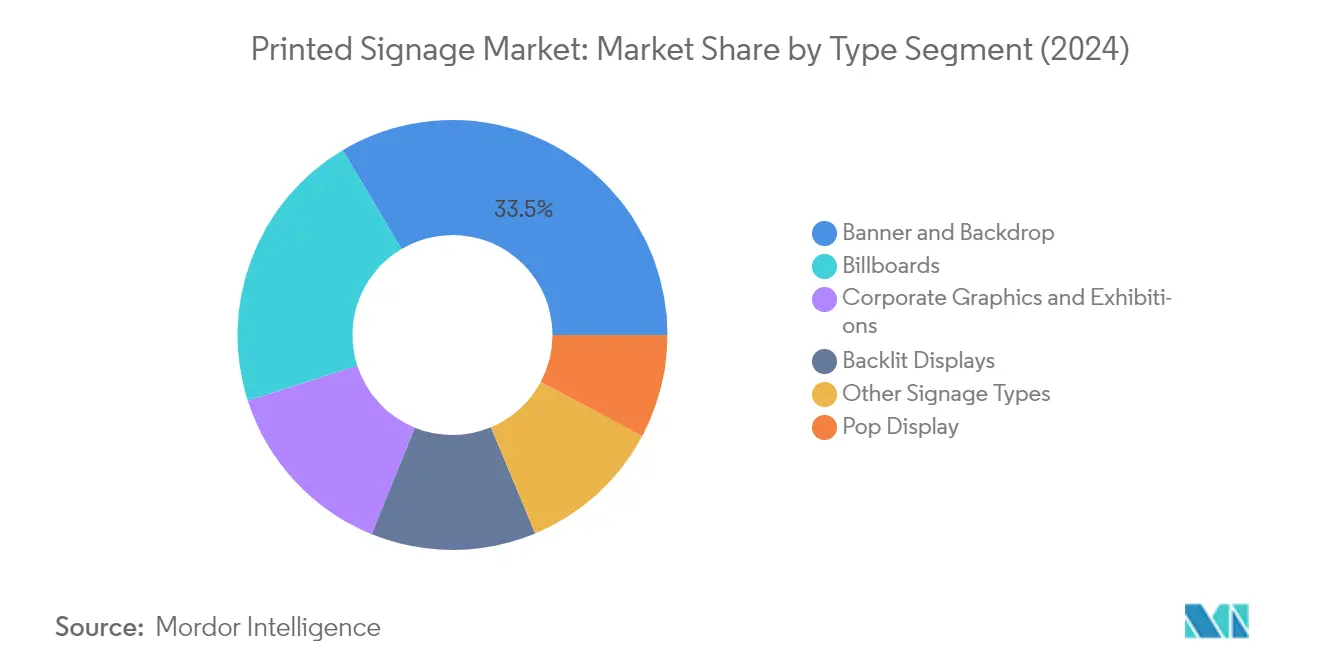
POP Display Segment in Printed Signage Market
The Point-of-Purchase (POP) Display segment is emerging as the fastest-growing segment in the printed signage market, projected to grow at approximately 0.92% during 2024-2029. This growth is primarily driven by the increasing focus on in-store marketing and the segment's effectiveness in influencing customer purchase decisions at the point of sale. POP displays, including ceiling danglers, headers, menu boards, and shelf-talkers, are proving particularly effective in creating excitement and highlighting promotions in retail environments. The segment's growth is further supported by the retail industry's continued emphasis on creating engaging shopping experiences and the effectiveness of POP displays in driving impulse purchases through strategically positioned promotional materials.
Remaining Segments in Printed Signage Market
The other significant segments in the printed signage market include Billboards, Corporate Graphics, Exhibitions & Trade Shows, Backlit Displays, and Other Signage Types. Billboards remain a crucial segment, particularly for outdoor advertising along highways and high-traffic areas. Corporate Graphics, Exhibitions & Trade Shows serve the business-to-business sector with specialized signage solutions for corporate events and trade shows. Backlit Displays continue to be popular in malls, airports, and retail environments, offering enhanced visibility through illuminated displays. The Other Signage Types segment encompasses various specialized applications including vehicle wraps, fleet graphics, and architectural signage, contributing to the market's diversity and comprehensive coverage of signage needs across different industries.
Segment Analysis: By Print Technology
Inkjet Segment in Printed Signage Market
The inkjet segment dominates the printed signage market, commanding approximately 84% market share in 2024. This segment's prominence can be attributed to its versatility in handling various substrates like vinyl, paper, and polyester, along with superior print quality and resolution capabilities. Inkjet technology has evolved significantly, incorporating advanced features in print head mechanics and expanding compatibility with different ink types including aqueous, ultraviolet, latex, and solvent inks. The technology particularly excels in outdoor applications like large-format signage, banners, and car wraps, where solvent inkjet proves highly economical. Additionally, inkjet printing machines come in various configurations including roll-based, flatbed, and hybrid structures, offering flexibility for different applications. The segment continues to attract substantial research and development investment, resulting in improvements in equipment quality, reliability, and automation capabilities for material handling.
Remaining Segments in Print Technology
The remaining segments in the print technology market include screen printing, sheetfed printing, and other specialized printing technologies. Screen printing, while traditional, maintains its relevance for applications requiring tactile and high-opacity inks on diverse substrates, particularly beneficial for large runs where screen costs can be distributed across multiple prints. Sheetfed printing serves the small and medium-sized print works market, offering enhanced quality control and the ability to use a wider variety of stocks. Other print technologies, including offset lithography, dye sublimation, and toner-based systems, continue to serve specific niches in the market where their unique capabilities provide advantages for particular applications. These technologies complement the market by offering specialized solutions for specific customer requirements and applications where inkjet might not be the optimal choice.
Segment Analysis: By End-User Vertical
Retail Segment in Printed Signage Market
The retail sector continues to dominate the printed signage market, commanding approximately 48% of the total market share in 2024. This significant market position is driven by the sector's extensive use of various signage formats, including posters, banners, backdrops, pop-up displays, and retail graphics. The retail industry's focus on expanding physical presence while investing considerably in advertising and marketing continues to fuel the demand for printed signage solutions. Retail signage plays a crucial role in instantly communicating messages to viewers, creating atmosphere and emotion that deliver on brand promises, and signposting key organizational messages. The segment's strength is further reinforced by the retail industry's strategic approach of utilizing a combination of digital and printed signage to maximize their marketing impact and profitability.
Healthcare Segment in Printed Signage Market
The healthcare segment is emerging as the most dynamic sector in the printed signage market, projected to grow at approximately 1% CAGR from 2024 to 2029. This growth is primarily driven by increasing healthcare expenditure across both public and private sectors, coupled with a growing emphasis on ensuring Medicare services reach their intended target base. The segment's expansion is further supported by pharmaceutical companies' significant investment in marketing and advertising activities, with many organizations allocating substantial budgets for promotional activities. Healthcare facilities are increasingly recognizing the importance of effective signage solutions for managing complex establishments, improving patient care, enhancing administration processes, and ensuring clear communication across various stakeholders including staff, clinicians, patients, doctors, and supervisors.
Remaining Segments in End-User Vertical
The transportation and logistics sector represents a significant portion of the printed signage market, utilizing signage solutions for fleet graphics, vehicle wraps, and cargo identification. The BFSI sector employs printed signage primarily for ATM locations, interior spaces, wall graphics, and promotional activities. These segments continue to maintain steady demand for printed signage solutions, though at a more moderate pace compared to retail and healthcare sectors. The other end-user verticals, including sports and entertainment sectors, contribute to market diversity through their unique requirements for event signage, promotional materials, and venue branding, demonstrating the versatility and continued relevance of printed signage across various industries.
Segment Analysis: By Application
Outdoor Printed Signage Segment in Global Printed Signage Market
The outdoor printed signage segment continues to dominate the global printed signage market, commanding approximately 61% of the total market share in 2024. This segment encompasses various forms of signage including billboards, outdoor banners, vehicle wraps, building-mounted signs, and ground-mounted displays that are specifically designed to withstand environmental elements. The segment's prominence is primarily driven by its effectiveness in reaching broad audiences, particularly in high-traffic areas and along major transportation routes. Outdoor printed signage remains a preferred choice for businesses looking to maximize visibility and brand exposure, especially in retail, real estate, and entertainment sectors. The durability and cost-effectiveness of outdoor printed signage, particularly for long-term advertising campaigns, continue to make it an attractive option for marketers and businesses seeking to maintain a consistent physical presence in their target markets.
Indoor Printed Signage Segment in Global Printed Signage Market
The indoor printed signage segment is emerging as the fastest-growing segment in the market, with a projected growth rate of approximately 0.4% during 2024-2029. This growth is being driven by increasing demand from retail stores, corporate offices, healthcare facilities, and educational institutions for point-of-purchase displays, wayfinding signage, and promotional materials. The segment is benefiting from technological advancements in printing techniques that enable higher quality outputs and more creative design possibilities. The expansion of retail spaces, shopping malls, and corporate facilities is creating new opportunities for indoor signage applications. Additionally, the growing focus on creating engaging indoor environments and enhanced customer experiences is driving the adoption of innovative indoor signage solutions. The segment is also seeing increased demand for customized and sustainable printing solutions that align with modern interior design trends and environmental considerations.
Printed Signage Market Geography Segment Analysis
Printed Signage Market in North America
North America represents a mature printed signage market, characterized by advanced technological adoption and shifting consumer preferences. The region's market dynamics are primarily shaped by the United States and Canada, with both countries experiencing transformations in their advertising landscapes. The retail sector remains a significant driver of printed signage market demand, while increasing competition from digital alternatives continues to influence market trajectories in both countries.
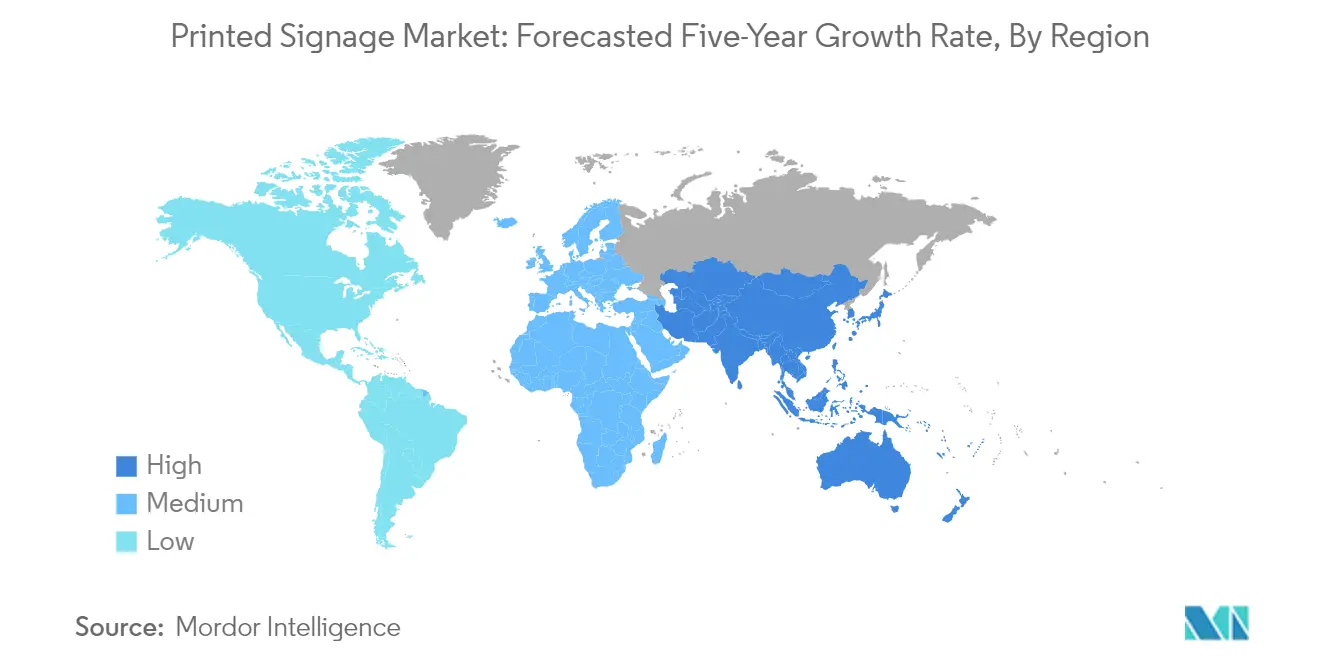
Printed Signage Market in United States
The United States dominates the North American printed signage market landscape as the largest market in the region. With approximately 91% share of the North American market in 2024, the country's printed signage market sector is driven by its extensive retail infrastructure and diverse commercial applications. The restaurant industry serves as a major contributor to market growth, with the National Restaurant Association comprising 1 million restaurant and foodservice outlets. The distinct appearance of custom signage continues to set businesses apart from the competition, leading vendors to offer specialized signage solutions across various sectors, including retail, healthcare, and transportation.
Printed Signage Market in Canada
Canada's printed signage market demonstrates resilience despite technological transitions. The market is projected to experience a growth rate of approximately -1.3% during 2024-2029, influenced by the gradual transition to digital signage. Despite this trend, the country maintains strong demand from its robust retail sector, with retail sales showing consistent growth. The restaurant industry remains a significant consumer of commercial signage, accounting for nearly 1.5% of the country's GDP. Canadian businesses continue to value custom signage for its cost-effectiveness and ability to create lasting impressions, particularly in small and medium-sized establishments.
Printed Signage Market in Europe
Europe maintains a significant position in the global printed signage market, with diverse adoption patterns across different countries. The region's market is characterized by a strong presence of established manufacturers and innovative printing technologies. The United Kingdom, Germany, and France represent the key markets, each with distinct characteristics and growth patterns influenced by their respective retail and commercial sectors.
Printed Signage Market in Germany
Germany stands as the largest printed signage market in Europe, commanding approximately 26% of the regional market share in 2024. The country's market is distinguished by its advanced technological integration, particularly in 3D printing applications for signage and retail displays. The presence of major trade fairs and exhibitions, such as FESPA, continues to drive innovation and market growth in the German printed signage sector, while maintaining strong demand across various commercial applications.
Printed Signage Market in Germany
Germany also leads the European region in terms of growth potential, with a projected growth rate of approximately 0.5% during 2024-2029. The country's market expansion is supported by continuous technological advancements in printing technologies and strong demand from retail and commercial sectors. The integration of sustainable practices and eco-friendly materials in signage production has become a key focus area for German manufacturers, driving innovation and creating new market opportunities.
Printed Signage Market in Asia-Pacific
The Asia-Pacific region represents the largest and most dynamic printed signage market globally. The region's market is characterized by rapid industrialization, expanding retail infrastructure, and increasing adoption of innovative printing technologies. The market benefits from continuous technological advancements and growing demand across various end-user segments, particularly in retail and corporate sectors. Local manufacturers are increasingly focusing on developing sustainable and eco-friendly signage solutions while also investing in advanced printing technologies to meet evolving customer requirements.
Printed Signage Market in Rest of the World
The Rest of the World region, encompassing the Middle East, Africa, and Latin America, presents diverse opportunities in the printed signage market. The region's growth is primarily driven by infrastructure development, retail expansion, and tourism industry requirements, particularly in the GCC countries. The market is witnessing increased adoption of advanced printing technologies and sustainable solutions, with significant investments in retail and commercial infrastructure driving demand. Trade shows and exhibitions, such as SGI Dubai, play a crucial role in showcasing the latest technologies and fostering market growth in these regions.
Printed Signage Industry Overview
Top Companies in Printed Signage Market
The printed signage market is characterized by companies focusing on continuous innovation and strategic expansion to maintain their competitive edge. Major players are investing heavily in research and development to introduce sustainable and environmentally friendly printing solutions while expanding their manufacturing capabilities through facility upgrades. Companies are increasingly adopting UV-cured finishing techniques and advanced printing technologies to offer shorter lead times and more durable products. Strategic partnerships and acquisitions remain key growth drivers, with firms looking to enhance their geographic presence and diversify their product portfolios. The industry has witnessed a significant trend toward developing integrated solutions that combine traditional printing capabilities with digital technologies, allowing companies to offer comprehensive business signage solutions to their customers.
Market Structure Shows Regional and Global Mix
The printed signage market exhibits a balanced mix of global conglomerates and regional specialists, with companies like Avery Dennison and 3A Composites operating globally while regional players like Signs Express and Kelly Signs maintain strong local market positions. The industry structure is moderately fragmented, with larger players leveraging their extensive distribution networks and comprehensive product portfolios to maintain market leadership. These established players often possess integrated operations spanning manufacturing, distribution, and installation services, providing them with significant competitive advantages in terms of cost efficiency and service delivery.
The market has witnessed considerable consolidation through strategic acquisitions and partnerships, particularly in mature markets. Global players are actively acquiring regional specialists to expand their geographic footprint and gain access to local customer bases. Companies are also forming strategic alliances with technology providers and material suppliers to strengthen their value proposition and enhance their competitive position. The franchise model has emerged as a popular growth strategy, particularly among regional players looking to expand their presence while maintaining local market expertise.
Innovation and Adaptability Drive Future Success
Success in the printed signage market increasingly depends on companies' ability to adapt to changing customer preferences and technological advancements. Market leaders are investing in advanced printing technologies and sustainable materials to differentiate their offerings and meet growing environmental concerns. Companies are also focusing on developing comprehensive service portfolios that include design, installation, and maintenance services to create stronger customer relationships and generate recurring revenue streams. The ability to offer customized solutions while maintaining cost efficiency has become crucial for maintaining market share.
For new entrants and smaller players, success lies in identifying and serving niche market segments while building strong local relationships. Companies must focus on developing specialized expertise in specific applications or industries to compete effectively against larger players. The increasing shift toward digital signage presents both a challenge and an opportunity, with successful companies developing hybrid solutions that combine printed and digital elements. Regulatory compliance, particularly regarding environmental standards and safety requirements, has become a critical factor in maintaining market position, with companies investing in sustainable practices and certifications to meet evolving requirements. The visual communication industry is poised for growth as companies innovate to meet these challenges.
Printed Signage Market Leaders
-
Avery Dennison Corporation
-
Kelly Signs Inc.
-
Spandex Ltd.
-
IGEPA group GmbH & Co. KG
-
Orafol Europe GmbH
- *Disclaimer: Major Players sorted in no particular order
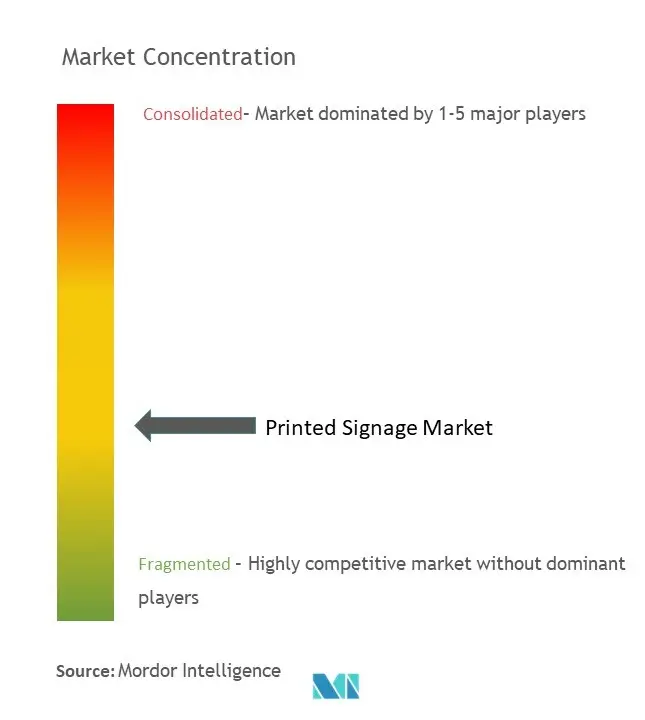
Printed Signage Market News
- February 2024: Kuhn Corp Print & Packaging strategically moved to fortify its position in the sign and display sector by successfully acquiring Regal Signs & Designs from its original owners. This acquisition is in line with Kuhn's commitment to expanding its signage operations and meeting growing customer demand, and it signifies a period of strategic growth for the company.
- December 2023: Panther Premier Print Solutions announced its recent acquisition of Advertising Arts, a company with a long-standing history of 74 years providing custom signage, decals, vehicle graphics, apparel, and promotional solutions.
- July 2023: Brother UK, a business technology solutions provider, launched a first-to-market multifunction printer as resellers move to support businesses wanting to produce high-quality signage and banners. The new MFC-J6959DW device is the first non-specialist, color inkjet printer proposing firms a way to create visuals, from sales banners to promotional signage.
Printed Signage Market Report - Table of Contents
1. INTRODUCTION
- 1.1 Study Assumptions and Market Definition
- 1.2 Scope of the Study
2. RESEARCH METHODOLOGY
3. EXECUTIVE SUMMARY
4. MARKET INSIGHTS
- 4.1 Market Overview
- 4.2 Industry Value Chain Analysis
-
4.3 Industry Attractiveness - Porter's Five Forces Analysis
- 4.3.1 Bargaining Power of Suppliers
- 4.3.2 Bargaining Power of Buyers
- 4.3.3 Threat of New Entrants
- 4.3.4 Threat of Substitute Products
- 4.3.5 Intensity of Competitive Rivalry
5. MARKET DYNAMICS
-
5.1 Market Drivers
- 5.1.1 Cost Effectiveness of Printed Signage
- 5.1.2 Inclination of the Retail Industry Toward the Application of Printed Signage
-
5.2 Market Restraints
- 5.2.1 High Competition from the Digital Signage Segment
6. MARKET SEGMENTATION
-
6.1 By Type
- 6.1.1 Banner and Backdrop
- 6.1.2 Corporate Graphics, Exhibitions, and Trade Shows
- 6.1.3 Backlit Displays
- 6.1.4 Pop Display
- 6.1.5 Billboards
-
6.2 By Print Technology
- 6.2.1 Screen
- 6.2.2 Inkjet
- 6.2.3 Sheetfed
-
6.3 By End-user Vertical
- 6.3.1 BFSI
- 6.3.2 Retail
- 6.3.3 Transportation and Logistics
- 6.3.4 Healthcare
-
6.4 By Application
- 6.4.1 Indoor
- 6.4.2 Outdoor
-
6.5 By Geography***
- 6.5.1 North America
- 6.5.1.1 United States
- 6.5.1.2 Canada
- 6.5.2 Europe
- 6.5.2.1 Germany
- 6.5.2.2 United Kingdom
- 6.5.2.3 France
- 6.5.2.4 Italy
- 6.5.3 Asia
- 6.5.3.1 China
- 6.5.3.2 India
- 6.5.3.3 Japan
- 6.5.3.4 South Korea
- 6.5.3.5 Thailand
- 6.5.3.6 Australia and New Zealand
- 6.5.4 Latin America
- 6.5.4.1 Brazil
- 6.5.4.2 Mexico
- 6.5.5 Middle East and Africa
- 6.5.5.1 United Arab Emirates
- 6.5.5.2 Saudi Arabia
- 6.5.5.3 South Africa
7. COMPETITIVE LANDSCAPE
-
7.1 Company Profiles*
- 7.1.1 Avery Dennison Corporation
- 7.1.2 Spandex Ltd
- 7.1.3 IGEPA group GmbH & Co. KG
- 7.1.4 Orafol Europe GmbH
- 7.1.5 Identity Group
- 7.1.6 Lintec Corporation
- 7.1.7 3A Composites Holding AG
- 7.1.8 Signs Express
- 7.1.9 EhKo Sign Industries KFT
- 7.1.10 Mactac LLLC (Lintec)
- 7.1.11 Kelly Signs and Graphics
- 7.1.12 L&H Sign Company Inc.
8. INVESTMENT ANALYSIS
9. FUTURE OF THE MARKET
Printed Signage Industry Segmentation
Signage printing refers to producing custom signs for various visual purposes. It is an innovative and cost-effective strategy that provides visibility to the business needs. The printed signage market report thoroughly analyzes the primary material, application, and geography.
The printed signage is segmented by type (banner and backdrop, corporate graphics, exhibitions, and trade shows, backlit displays, pop displays, billboards, and other types), print technology (screen, inkjet, sheetfed, and other print technology), end-user vertical (BFSI, retail, transportation and logistics, healthcare, and other end-user vertical), application (indoor and outdoor), and geography (North America [the United States and Canada], Europe [Germany, United Kingdom, France, and Rest of Europe], Asia-Pacific [China, India, Japan, South Korea, Thailand, and Rest of Asia-Pacific], Latin America [Brazil, Mexico, and Rest of Latin America], and Middle East and Africa [United Arab Emirates, Saudi Arabia, South Africa, and Rest of the Middle East and Africa]). The market sizes and forecasts are provided in terms of value (USD) for all the above segments.
| By Type | Banner and Backdrop | ||
| Corporate Graphics, Exhibitions, and Trade Shows | |||
| Backlit Displays | |||
| Pop Display | |||
| Billboards | |||
| By Print Technology | Screen | ||
| Inkjet | |||
| Sheetfed | |||
| By End-user Vertical | BFSI | ||
| Retail | |||
| Transportation and Logistics | |||
| Healthcare | |||
| By Application | Indoor | ||
| Outdoor | |||
| By Geography*** | North America | United States | |
| Canada | |||
| Europe | Germany | ||
| United Kingdom | |||
| France | |||
| Italy | |||
| Asia | China | ||
| India | |||
| Japan | |||
| South Korea | |||
| Thailand | |||
| Australia and New Zealand | |||
| Latin America | Brazil | ||
| Mexico | |||
| Middle East and Africa | United Arab Emirates | ||
| Saudi Arabia | |||
| South Africa | |||
Printed Signage Market Research FAQs
How big is the Printed Signage Market?
The Printed Signage Market size is worth USD 42.53 billion in 2025, growing at an 1.56% CAGR and is forecast to hit USD 45.96 billion by 2030.
What is the current Printed Signage Market size?
In 2025, the Printed Signage Market size is expected to reach USD 42.53 billion.
Which is the fastest growing region in Printed Signage Market?
Asia Pacific is estimated to grow at the highest CAGR over the forecast period (2025-2030).
Which region has the biggest share in Printed Signage Market?
In 2025, the Asia Pacific accounts for the largest market share in Printed Signage Market.
What years does this Printed Signage Market cover, and what was the market size in 2024?
In 2024, the Printed Signage Market size was estimated at USD 41.87 billion. The report covers the Printed Signage Market historical market size for years: 2019, 2020, 2021, 2022, 2023 and 2024. The report also forecasts the Printed Signage Market size for years: 2025, 2026, 2027, 2028, 2029 and 2030.
Our Best Selling Reports
Printed Signage Market Research
Mordor Intelligence provides a comprehensive analysis of the printed signage market, utilizing our extensive expertise in visual communication research. Our latest report explores a wide range of solutions, including custom signage, banner printing, and large format printing technologies. The analysis covers various segments such as outdoor signage, indoor signage, commercial signage, and architectural signage. It offers detailed insights into business signage applications and emerging trends in vinyl signage solutions.
Stakeholders across the visual communication industry will benefit from our detailed examination of retail signage developments, wayfinding signage innovations, and promotional signage strategies. The report is available as an easy-to-download PDF, offering valuable insights into advertising signage implementations, display printing technologies, and digital printing signage advancements. Our analysis includes POS signage, retail graphics, and point of purchase signage applications. It ensures comprehensive coverage of the large format printing industry while addressing specific needs in large format printing market segments.

